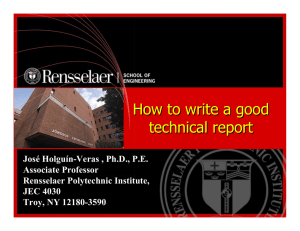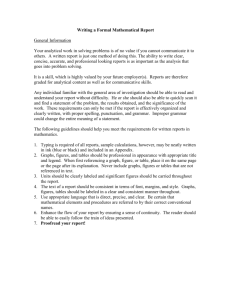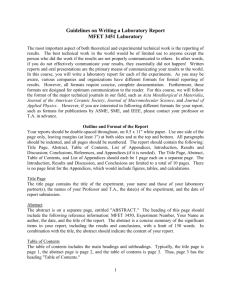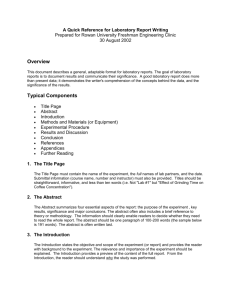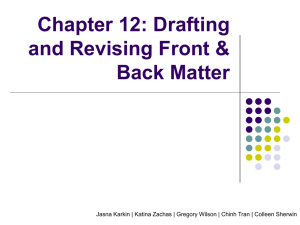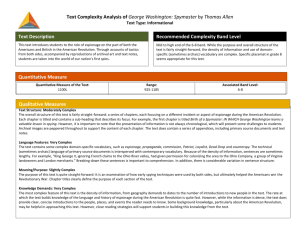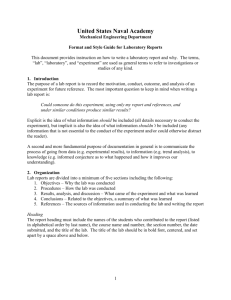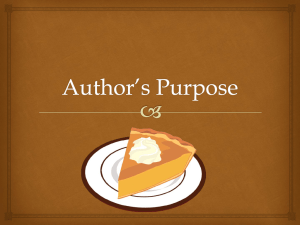Scientific Report Writing
advertisement
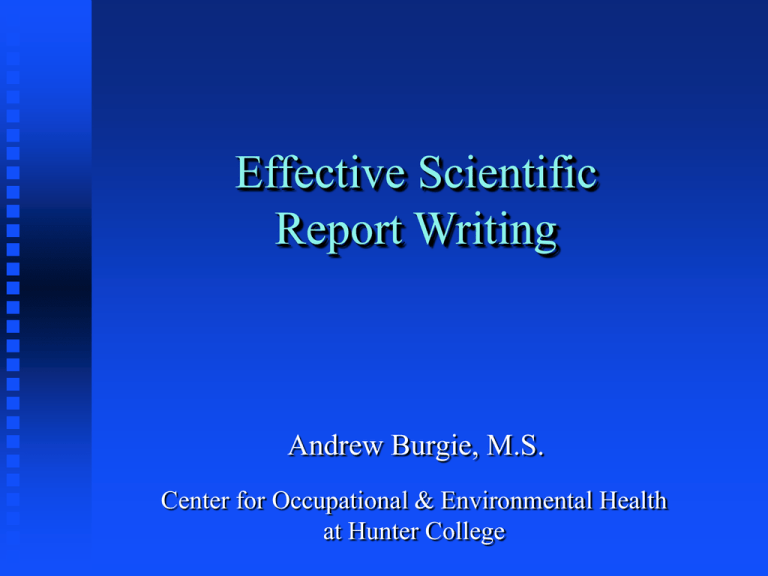
Effective Scientific Report Writing Andrew Burgie, M.S. Center for Occupational & Environmental Health at Hunter College Course Overview Scientific Report Section Overview Typical IH Report Sections Purpose Systematic Approach to Writing Scientific Report Sections Scientific Report Writing Other Important Issues and Topics Conclusion/Questions/Discussion Bibliography Scientific Report Writing Overview Aim The main purpose of a scientific report is to communicate A report should convey essential information and ideas as concisely and effectively as possible Precise formats vary by discipline and scientific journal; treat them as flexible guidelines that enable clear communication Scientific Report Writing Overview Audience Assume that your intended reader has a background similar to yours before you started the project The reader has general understanding of the topic but no specific knowledge of the details The reader should be able to reproduce whatever you did by following your report Scientific Report Section Overview Executive Summary – “Aim” & “Audience” Introduction Purpose Scope of Work Sampling Methods Results Observations Conclusions Recommendations Appendices Typical IH Report Sections Executive Summary (1-2 paragraphs maximum) Introduction (site background) Purpose (why was survey done) Scope of Work (what was/was not surveyed) Sampling Methods (what used and how) Results (what were the findings) Observations (useful info outside of results; i.e. climate) Conclusions/Discussion (what did you deduce) Recommendations [solution(s) to survey issue(s)] Appendices (supporting maps, graphs, tables, etc.) Systematic Approach to Writing Scientific Report Sections Title Abstract Introduction Methods Results Discussion Appendices (Tables and Figures) © 2002 The University of Wisconsin-Madison Writing Center Scientific Report Sections Title Describe contents clearly and precisely Provide key works for indexing Avoid wasted words (i.e., “an investigation of”) Avoid abbreviations and jargon Convey subject seriousness; no “cute” titles Scientific Report Sections Abstract Convey whole report in miniature, minus specific details State main objectives Describe methods Summarize most important results State major conclusions and their significance Do not include references to figures, tables, or sources Do not include info not in report Scientific Report Sections Introduction What is the problem? Why is it important? What solution (or step toward a solution) do you propose? Move from general to specific examples Engage your reader / audience Make the information links clear Be selective about your citations Scientific Report Sections Methods How did you study the problem? What did you use? (materials) How did you proceed? (methods/procedures) Provide enough detail for study replication Order procedures by type or chronology Use past tense Quantify when possible Do not mix results with procedures Scientific Report Sections Results What did you observe? Briefly describe experiment Report main result(s) supported by selected data Order multiple results logically (i.e., “most to least important; simple to complex; etc”.) Use past tense Do not simply repeat table data; select key info Do not interpret results Avoid extra words Scientific Report Sections Discussion What do your observations mean? What conclusions can you draw? How do your results fit into a broader context? Summarize the most important findings Move from specific discussion to general Do not ignore or bury the major issue Make explanations complete Do not over-generalize Do not ignore deviations in your data Avoid speculation that cannot be tested in foreseeable future Scientific Report Sections Appendices (Tables and Figures) Tables are referred to as “tables”, and all other items (graphs, photographs, drawings, diagrams, maps, etc.) are referred to as “figures” Tables and figures are assigned numbers in the order they are mentioned in the text Tables and figures are numbered independently of each other (i.e., “Table 1 then 2; and Figure 1 then 2, regardless of Table / Figure order”) Scientific Report Sections Appendices (Tables and Figures) Tables are labeled at the top and figures at the bottom. Tables and figures may be placed at the end of the paper, or within the text as soon as possible after they are mentioned without interrupting the text i.e., “at the end of a paragraph or section”. Check with your supervisors for their preference. Scientific Report Sections Appendices (Tables and Figures) Each table or figure MUST be introduced within the text, and the comment should point out the highlights: e.g., “The temperature increased on the third day (Figure 1)”. All tables and figures MUST be numbered and have self-explanatory titles so that the reader can understand their content without the text: e.g., “Table 1. Percent of soybean plants exhibiting visible injury after exposure to acid precipitation”. Systematic Approach to Writing Scientific Report Writing Aim Audience Clarity of Writing Supporting Material Language and Style Consistency of Format © 1999 Andrew C. Comrie (University of Arizona, Dept. of Geography and Regional Development) Scientific Report Writing Aim The main purpose of a scientific report is to communicate A typical structure and style have evolved to convey essential information and ideas as concisely and effectively as possible Precise formats vary by discipline and scientific journal, but always treat them as flexible guidelines that enable clear communication Scientific Report Writing Audience Assume that your intended reader has a background similar to yours before you started the project The reader has general understanding of the topic but no specific knowledge of the details The reader should be able to reproduce whatever you did by following your report Scientific Report Writing Clarity of Writing Good scientific reports share many of the qualities found in other kinds of writing To write is to think; a paper that lays out ideas in a logical order will facilitate same kind of thinking Make each sentence follow from the previous one, building an argument piece by piece Group related sentences into paragraphs, and group paragraphs into sections Create a flow from beginning to end Scientific Report Writing Supporting Materials Use figures, tables, data, equations, etc. to help tell the story as it unfolds Refer to them directly in the text, and integrate the points they make into your writing Number figures and tables sequentially as they are introduced (e.g., “Figure 1, Figure 2, etc., with another sequence for Table 1, Table 2, etc.”) Scientific Report Writing Supporting Materials (continued) Provide captions with complete information and not just a simple title Label all axes and include units Insert a figure or table after the paragraph in which it is first mentioned, or, gather all supporting material together after the reference section (before any appendices) Scientific Report Writing Language and Style The report should be grammatically sound, with correct spelling, and generally free of errors Avoid jargon, slang, or colloquial terms Define acronyms and any abbreviations not used as standard measurement units Most of the report describes what you did, and thus it should be in the past tense, but use present or future tense as appropriate. Employ the active rather than passive voice to avoid boring writing and contorted phrases Scientific Report Writing Consistency of Terms Within the report, the exact format of particular items is less important than consistency of application. i.e., “if you indent paragraphs, indent them all” “use a consistent style of headings throughout” “write "%" or "percent”, do not mix them, etc.” Establish a template and stick to it. Consult real journal papers for examples. Systematic Approach to Writing Other Important Issues and Topics Industrial Hygiene Ethics Law and Order: Is Report Legal-Proof? Power of Persuasion: Are Readers Buying It? Is it “Clean” or “Below Level of Detection”? Spelling Demons/Word Bloopers & Blunders Other Important Issues and Topics Industrial Hygiene Ethics: IH’s shall: Practice their profession following recognized scientific principles with the realization that the lives, health, and well-being of people may depend upon their professional judgment and that they are obligated to protect the health and well-being of people. Counsel affected parties factually regarding potential health risks and precautions necessary to avoid adverse health effects. Keep confidential personal and business information obtained during the exercise of industrial hygiene activities, except when required by law or overriding health and safety considerations. Avoid circumstances where a compromise of professional judgment or conflict of interest may arise. Perform services only in the areas of their competence. Act responsibly to uphold the integrity of the profession. Other Important Issues and Topics Law and Order: Is Report Legal-Proof? Calibration – Do it and Document It Make sure that conclusions drawn logically reflect results actually obtained Make sure recommendations solve the root problem and not just the symptoms whenever possible i.e., “replacing moldy carpeting without fixing leaking source is not solving problem” Have legal department review draft report Other Important Issues and Topics Power of Persuasion: Are Readers Buying It? Will your report influence policy change(s)? Will your report fend off a cut in budget? Will your report result in an increased budget? Will your report inspire accident prevention? Allow time in between self-reviewing report Let experienced colleagues review report draft Review good persuasive literature for ideas Other Important Issues and Topics Is it “Clean” or “Below Level of Detection”? Avoid over-extrapolating results Make sure survey performed addresses root issue; if not rethink survey Make sure the proper materials and methodologies are used Make sure survey addresses “worst case scenarios” for credibility, if applicable Know and convey limitations of survey in report (disclaimers) Other Important Issues and Topics Spelling Demons/Word Bloopers & Blunders Remember ABC’s: accuracy, brevity, clarity Avoid: Professional pomposity ($100 words vs. $5 words) Barbarisms (non-existent words or expressions) Solecisms (ungrammatical use of English) Syntax errors Use of incorrect/dehumanizing words Use of “empty” phrases or words Sexism (use plural or “one” vs. “him/her”) Excessive use of abbreviations Plagiarism CONCLUSION Questions and Discussion Bibliography _____________________________________ ANDREW BURGIE, M.S. Center for Occupational and Environmental Health at Hunter College Bibliography The University of Wisconsin-Madison Writing Center, 2007: The Writer’s Handbook: Scientific Reports. Internet: <http://www.wisc.edu/writing/Handbook/Sc ienceReport.html>. Comrie, A.C., 2007: Scientific Report Writing. Internet: <http://www.geog.arizona.edu/~comrie/geo g230/report.htm>. Bibliography Iowa State University College of Agriculture, 2007: Word Usage in Scientific Writing. Internet: <http://www.ag.iastate.edu/aginfo/word_usa ge.php>. The Learning Commons, University of Guelph, 2007: Fastfacts: Writing Scientific Lab Reports. Internet: <http://osprey.lib.uoguelph.ca/assistance/wri ting_services/components/documents/lab_re port.pdf>.
